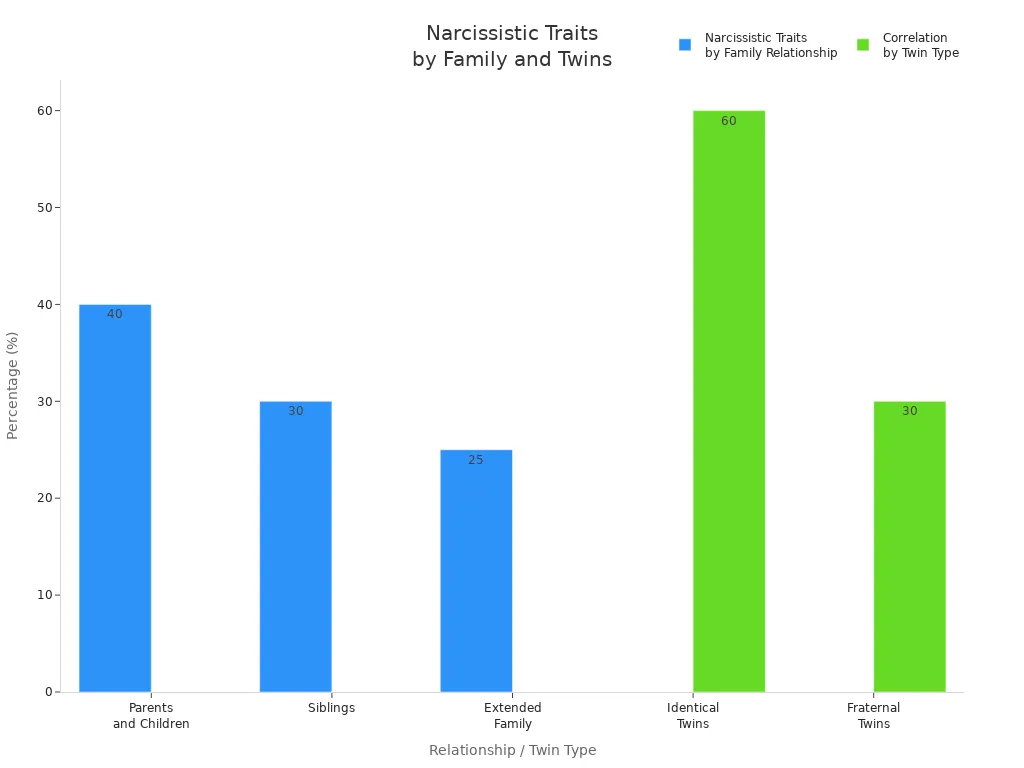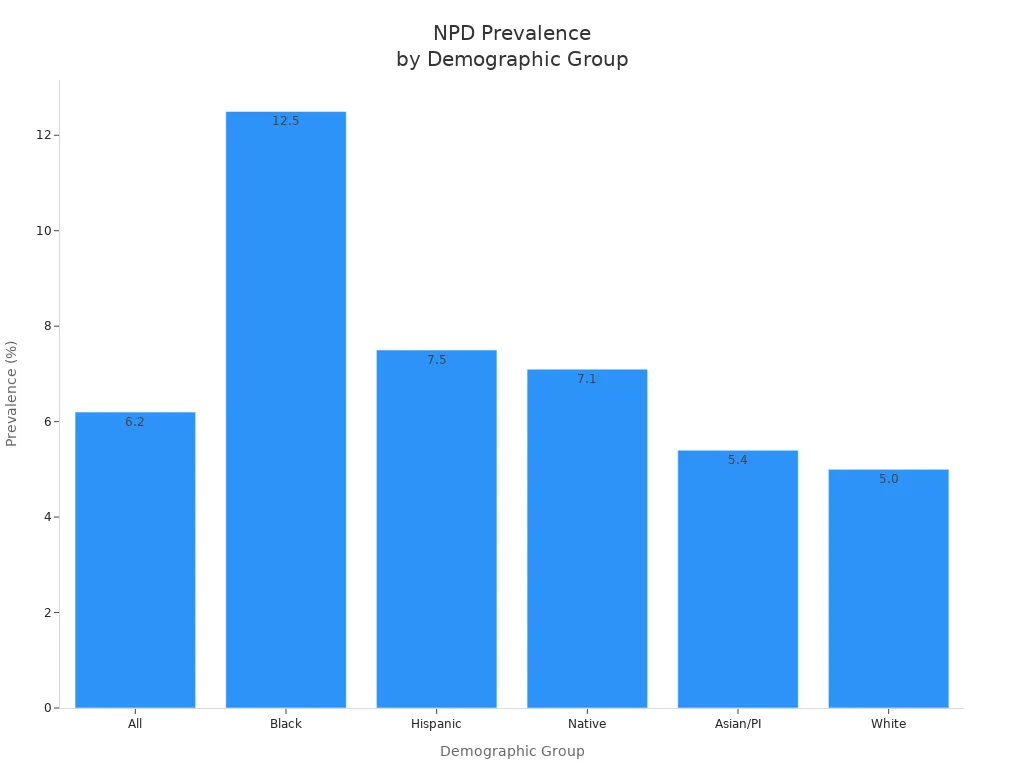Last updated on December 17th, 2025 at 01:46 am
Is Narcissism Genetic? Have you ever wondered if narcissism runs in families or if life experiences shape it more? Recent studies show both genetics and environment play a role.
Twin research found that genetic factors account for up to 35% of certain narcissistic traits, while family experiences such as parental overvaluation have a strong impact.
TL;DR
- Narcissism is influenced by both genetics and environment, with studies showing genetics account for 30% to 60% of narcissistic traits.
- Twin studies reveal that identical twins share more narcissistic traits than fraternal twins, indicating a genetic basis.
- Parental overvaluation, such as excessive praise, can lead to the development of narcissistic traits in children.
- Narcissism is not solely genetic; environmental factors like childhood experiences play a crucial role in shaping these traits.
- There is no single ‘narcissism gene’; many small genetic factors contribute to the risk of developing narcissistic traits.
- Understanding the balance between genetics and environment can empower individuals to manage narcissistic traits effectively.
You can see this balance in the data below:
Evidence Type | Findings |
|---|---|
Genetic Influence | Heritability of narcissism traits (23% for intrapersonal grandiosity, 35% for entitlement). |
Environmental Influence | Overvaluation by parents and adverse childhood experiences also contribute significantly. |
Is Narcissism Genetic

Understanding whether narcissism is genetic can help you see why some people develop these traits while others do not. Researchers have spent years studying the roots of narcissism, using tools like the Narcissistic Personality Inventory (NPI) and large family studies. Let’s break down what the data shows.
Research Data Analysis
Twin Studies
Twin studies give you a unique window into the genetic side of narcissism. By comparing identical twins (who share all their genes) to fraternal twins (who share about half), scientists can estimate how much genetics influence personality traits.
Type of Twins | Average Correlation in Narcissistic Traits (%) |
|---|---|
Identical Twins | 60% |
Fraternal Twins | 30% |
You can see that identical twins show much higher similarity in narcissistic traits than fraternal twins. This suggests a moderate genetic basis. Family studies also show that parents and children share about 40% of these traits, while siblings share 30%. Extended family members show a 25% overlap.

Heritability Estimates
When you ask, “Is Narcissism Genetic (Research Data Analysis)?” heritability estimates provide a clear answer. Twin studies report heritability rates between 30% and 60%. Family studies find similar numbers, with 40% to 50% of narcissistic traits explained by genetics.
Study Type | Heritability Estimate (%) |
|---|---|
Twin Studies | 30 – 60 |
Family Studies | 40 – 50 |
But not all types of narcissism are equally genetic. For example:
Narcissistic Personality Disorder (NPD) shows a heritability rate of 0.64 (64%).
Vulnerable narcissism is less genetic, with less than 23% explained by genes.
Grandiose narcissism is shaped more by environment than by genetics.
“Narcissism is a complex interplay of nature and nurture. While there may be a genetic predisposition, it’s the environmental factors – particularly early childhood experiences – that often shape and reinforce narcissistic traits” (Durvasula, 2019).
Behavioral Genetic Studies
Behavioral genetic studies use tools like the NPI to measure narcissism and look for patterns in families and twins. These studies show that genetic effects on narcissism are mostly additive. This means that many small genetic influences add up, rather than one gene causing the trait.
Study | Findings |
|---|---|
Chen et al. (2013) | Heritability of narcissism and impulsive buying, indicating genetic effects are additive. |
Vernon et al. (2008) | Genetic effects on narcissism are additive rather than dominant. |
Luo et al. (2014) | Based on the same sample and measure (NPI), supports the additive genetic effects on narcissism. |
Other studies use behavior genetics analysis with twins to separate genetic and environmental influences. For example, one study with 304 pairs of twins found that both genes and environment shape narcissism, but the balance depends on the type of narcissism.
Study Title | Key Findings | Methodology |
|---|---|---|
Exploring grandiose narcissism among surgeons | Genetic predisposition and environmental factors interact to determine narcissism expression. | Analysis of grandiose narcissism using NARC, considering cognitive, affective-motivational, and behavioral aspects. |
Distinguishing communal narcissism from agentic narcissism | Examined genetic and environmental bases of agency–communion model of narcissism. | Behavior genetics analysis with a sample of 304 pairs of twins. |
Recent Findings (2020-2024)
Recent research continues to update our understanding of “Is Narcissism Genetic (Research Data Analysis)?” Studies published between 2020 and 2024 confirm that genetics play a moderate role, but environment remains crucial. For example, new twin studies show heritability estimates for narcissistic traits still range from 30% to 60%. Family studies echo these results.
Researchers also find that environmental factors, such as parental overvaluation and early life experiences, can increase or decrease narcissistic traits, even in people with a genetic predisposition. This means you are not “doomed” by your genes. Your environment and choices matter.
Common Misconceptions About the Genetic Basis of Narcissism
You might hear myths about narcissism and genetics. Let’s clear up some common misconceptions with facts from recent research:
Narcissism is not 100% genetic.
Even with a family history, environment shapes how these traits develop.No single “narcissism gene” exists.
Many small genetic factors add up, but no one gene causes narcissism.Grandiose and vulnerable narcissism differ.
Grandiose narcissism is more influenced by environment, while vulnerable narcissism has a lower genetic component.Having narcissistic traits does not mean you will develop Narcissistic Personality Disorder (NPD).
Diagnosis depends on many factors, not just genetics.You can change.
Genetics set the stage, but environment, therapy, and self-awareness can make a big difference.
When you ask, “Is Narcissism Genetic (Research Data Analysis)?” remember that both nature and nurture play important roles. The latest research shows a moderate genetic influence, but your experiences and choices shape the outcome.
Inheritance and Family Risk
Understanding how narcissism passes through families helps you see the bigger picture. You might wonder if having a parent with narcissistic traits means you will develop them too. Research shows that both genetics and family environment play important roles.
Parental Influence
Overvaluation Effects
Parents shape your self-image from a young age. When parents overvalue their children—praising them excessively or treating them as special above others—children may start to believe they are superior. This belief can lead to narcissistic traits. Parenting styles matter. Overprotective parenting often increases narcissistic tendencies.
Emotional struggles, such as perfectionism and shame, also contribute. Children who feel they must always be perfect or who experience frequent criticism may develop a fragile sense of self.
Children begin to show signs of narcissism as early as age 8. The Dynamic Self-Regulatory Processing Model explains that narcissism is a persistent process driven by the need for a positive self-view. This need can cause emotional instability.
You may notice that children with narcissistic traits often struggle with anxiety and depression. In children with oppositional defiant disorder (ODD), narcissism links to more emotional symptoms, such as worry and psychosomatic complaints.
Intergenerational Patterns
Narcissism can run in families. Studies show that if a parent has narcissistic personality disorder (NPD), the risk for children increases. Family studies reveal that the risk of inheriting narcissism can exceed 50%. Here are some key findings:
Several studies report inheritance risk above 50%.
One study found a heritability score of 53%.
Norwegian research suggests about 33% of narcissism disorder is genetic.
A 2007 study determined a 59% genetic effect on narcissism.
You can see that genetics play a significant role, but not the only one.
Genetic vs. Environmental Factors
Both genetic and environmental factors interact to shape narcissistic traits. You inherit certain temperaments and emotional regulation abilities from your parents. If your family has a history of NPD or other personality disorders, your risk increases.
However, your environment also matters. Childhood trauma and chronic stress can change how your genes work through epigenetic modifications, such as DNA methylation.
Evidence Type | Description |
|---|---|
Genetic Factors | Heritability of personality disorders estimated at 30%–60%. Genes involved in neurotransmitter regulation play a role. |
Environmental Factors | Childhood trauma and chronic stress interact with genetic predispositions, leading to epigenetic changes. |
Genetics influence the development of narcissistic personality disorder (NPD).
Inherited traits like temperament and emotional regulation issues contribute to risk.
Individuals with a family history of NPD are more likely to develop NPD themselves.
Environmental and Other Factors
You might wonder why some people develop narcissistic traits even without a strong family history. The answer often lies in the environment around you. Let’s look at how parenting, culture, and even your brain can shape narcissism.
Parenting and Upbringing
Your early years play a big role in shaping your personality. Parenting styles can either encourage healthy self-esteem or push you toward unhealthy narcissism. Researchers have found that:
Positive parenting, like giving support and setting clear boundaries, helps you develop a balanced sense of self.
Negative parenting, such as inconsistent discipline or ignoring your feelings, links to vulnerable narcissism. You may feel insecure or crave approval.
Too much praise or excessive positive reinforcement can lead to grandiose narcissism. You might start to believe you are better than others and deserve special treatment.
Experts still debate which parenting styles matter most. Some studies show mixed results, so more research is needed.
Children who grow up with parents who overvalue them may develop an inflated self-image. On the other hand, harsh or neglectful parenting can make you feel unworthy, which sometimes leads to seeking attention in unhealthy ways.
Socio-Cultural Influences
The culture you live in shapes how you see yourself and others. Some cultures encourage you to stand out, while others ask you to fit in. Here’s what studies show:
Individualistic cultures, like those in the United States, value personal achievement. This can make narcissistic traits more common and even accepted.
Collectivist cultures focus on group harmony. You may hide narcissistic traits to avoid conflict, but the underlying feelings can still exist.
Cultures that reward status and success, known as vertical individualism, often see higher levels of narcissism.
In cultures that value teamwork and equality, called horizontal collectivism, people show fewer antagonistic narcissistic traits.
Mental health professionals must consider your cultural background when assessing narcissism. What looks like confidence in one culture might seem like arrogance in another.
You may also notice that narcissism affects how people treat the environment. Studies show that:
Grandiose and vulnerable narcissism both link to less care for the environment.
People with these traits often feel less control over environmental issues.
Grandiose narcissism, in particular, connects to negative attitudes and behaviors toward the environment.
Neurobiology
Your brain and body chemistry also play a part in narcissism. Scientists have found several biological factors that can influence these traits:
Oxytocin can make people with narcissistic personality disorder act more manipulative. They may seem trustworthy while hiding dishonest actions.
Vasopressin levels can rise when someone with NPD feels threatened, leading to aggressive or retaliatory behavior.
Problems in the prefrontal cortex can cause poor impulse control and a lack of empathy. This makes it harder to make ethical choices.
An overactive amygdala can trigger strong emotions like fear or anger, especially if someone challenges your self-importance.
Types and Diagnosis

Understanding narcissism means looking at its different forms and how professionals diagnose it. You might notice that not everyone with narcissistic traits acts the same way.
Some people show their self-importance openly, while others hide it behind insecurity. Let’s break down the main types and how experts identify narcissistic personality disorder (NPD).
Types of Narcissism
Researchers have found that narcissism is not one-size-fits-all. You can see the main types in the table below, based on how people score on admiration (wanting praise) and rivalry (competing with others):
Narcissistic Type | Description |
|---|---|
Non-narcissistic individuals | Low scores on both admiration and rivalry. |
Subclinical vulnerable narcissists | Moderate scores on rivalry, low on admiration. |
Grandiose narcissists | High scores on admiration, low on rivalry. |
Grandiose-vulnerable narcissists | Elevated levels on both admiration and rivalry. |
Grandiose
Grandiose narcissism stands out. You might see someone who loves attention, talks about their achievements, and expects special treatment. They often seem confident and charming at first.
For example, a student who always wants to be the group leader and brags about their grades may show grandiose traits. Research shows that grandiose narcissists score high on admiration but low on rivalry. They want praise but do not always compete aggressively.
Vulnerable
Vulnerable narcissism looks different. You may notice someone who feels insecure, worries about what others think, and reacts strongly to criticism. They might seem shy or sensitive, but inside, they crave recognition.
For instance, a coworker who avoids group projects but gets upset if not praised may fit this type. Vulnerable narcissists often score higher on rivalry and lower on admiration. They may not seek the spotlight, but they still want to feel special.
Tip: Grandiose narcissism is often called “overt,” while vulnerable narcissism is “covert.” Both types can cause problems in relationships, but they show up in different ways.
NPD Diagnosis
DSM-5 Criteria
Mental health professionals use the DSM-5 to diagnose NPD. You need to meet at least five of these nine criteria:
A grandiose sense of self-importance
A fixation on fantasies of unlimited success, power, brilliance, beauty, or ideal love
A belief that one is special and can only be understood by, or should associate with, other special or high-status people
A need for excessive admiration
A sense of entitlement
Interpersonally exploitative behavior
A lack of empathy
Envy of others or a belief that others are envious of them
A display of arrogant or haughty behaviors or attitudes
You might recognize some of these traits in people around you, but only a trained professional can make a diagnosis.
Assessment Tools
Clinicians use several tools to measure narcissism. One of the most reliable is the Narcissistic Personality Inventory-13 (NPI-13):
The NPI-13 provides a quick and accurate way to assess narcissistic traits.
It has strong reliability and validity, according to recent research.
Professionals use it to help diagnose NPD and track changes over time.
If you wonder about your own traits, remember that only a mental health expert can give you a full assessment. Early recognition and support can make a big difference.
Prevalence and Implications
NPD in the U.S.
You might wonder how common narcissistic personality disorder (NPD) is in the United States. Researchers estimate that NPD affects between 0.5% and 6.2% of the general population. Most studies suggest that about 0.5% to 5% of people may experience NPD at some point in their lives. Men tend to show higher rates than women.
Here’s a quick look at how NPD appears across different groups:
Demographic | Prevalence (%) |
|---|---|
All | 6.2 |
Black | 12.5 |
Hispanic | 7.5 |
Native | 7.1 |
Asian/PI | 5.4 |
White | 5.0 |

You can see that NPD affects people from all backgrounds, but rates vary. Black Americans show the highest prevalence, while White and Asian/Pacific Islander groups show lower rates. These numbers highlight the importance of understanding NPD as a mental health concern for everyone.
NPD can have a big impact on your life and relationships. People with NPD often struggle with trust, emotional intimacy, and self-esteem. Families may notice patterns like people-pleasing, chronic self-blame, or difficulty making decisions.
Some individuals feel unlovable or “not good enough.” Others may develop insecure attachment styles or find themselves in co-dependent or abusive relationships. The risk of mental health issues, such as depression and anxiety, increases when NPD is present in the family.
Adults who grew up with a narcissistic caregiver often report higher rates of depression and low self-esteem. This shows how deeply NPD can affect emotional health.
Practical Takeaways
If you or someone in your family struggles with narcissistic traits, you can take steps to protect your well-being. Here are some practical strategies based on recent research:
Focus on behavior, not labels. Pay attention to actions rather than trying to guess intentions.
Document interactions. Keep records of important conversations or decisions.
Be a safe parent. Offer empathy and validate your child’s feelings, but avoid making emotions bigger than they are.
Teach healthy coping skills. Help your child learn problem-solving and relationship strategies.
Practice radical acceptance. Accept the situation as it is, even if it feels difficult.
Plan safe exchanges. Arrange pick-ups and drop-offs in public places.
Consider parallel parenting. Limit direct interaction if conflict is high.
You can also support your child by:
Getting them into cognitive behavioral therapy (CBT).
Encouraging journaling to process feelings.
Teaching problem-solving techniques.
Overseeing social media use to prevent negative influences.
Future Directions
Research Gaps
You might wonder what scientists still need to learn about narcissism. Researchers have made progress, but many questions remain. You see studies that show both genetics and environment matter, but the balance between these factors is not clear. Future research should focus on how genes and life experiences interact over time.
Many studies use twins and families to estimate heritability. These studies show that genetics explain part of narcissism, but not all of it. You need more research that tracks people from childhood into adulthood. This approach helps you understand how early experiences shape personality traits.
Researchers also need to look at different types of narcissism. Grandiose and vulnerable narcissism may have unique genetic and environmental roots. You benefit from studies that separate these types and explore how they develop.
Here are some areas where future research can make a difference:
Genetic predisposition includes inherited traits like high extroversion and low agreeableness, which can increase susceptibility to narcissistic behaviors.
Environmental influences, particularly parenting styles, play a crucial role in shaping narcissistic traits, with excessive praise or neglect leading to entitlement or feelings of inadequacy.
Long-term studies can show how genes and environment work together.
Researchers should use larger and more diverse samples to improve accuracy.
You need more research on how culture and social media affect narcissism.
Note: Scientists continue to debate how much genetics versus environment shapes narcissism. You can expect new findings as technology and research methods improve.
Conclusion
You have learned that both genetics and environment shape narcissism. Genes can increase your risk, but parenting, culture, and childhood experiences play major roles. Take a look at the key influences:
Factor | Impact on Narcissism |
|---|---|
Genetic Factors | Raise predisposition |
Family History | Higher risk with affected relatives |
Childhood Experiences | Trauma or neglect can boost traits |
Frequently Asked Questions
What causes narcissism to develop?
You see narcissism develop from a mix of genetics and environment. Family history, parenting style, and early life experiences all play a role. No single cause explains it. Both nature and nurture shape these traits.
Can you inherit narcissism from your parents?
You can inherit a genetic risk for narcissism. If your parent has narcissistic traits or narcissistic personality disorder, your risk increases. Environment and upbringing also matter. Inheritance does not guarantee you will develop narcissism.
Is there a specific gene for narcissism?
No single gene causes narcissism. Many small genetic factors add up to increase risk. Scientists have not found a “narcissism gene.” Your environment and choices still shape how these traits appear.
Are men more likely to have narcissistic personality disorder?
Research shows men have higher rates of narcissistic personality disorder than women. Both men and women can show narcissistic traits. Cultural expectations may influence how these traits appear.
